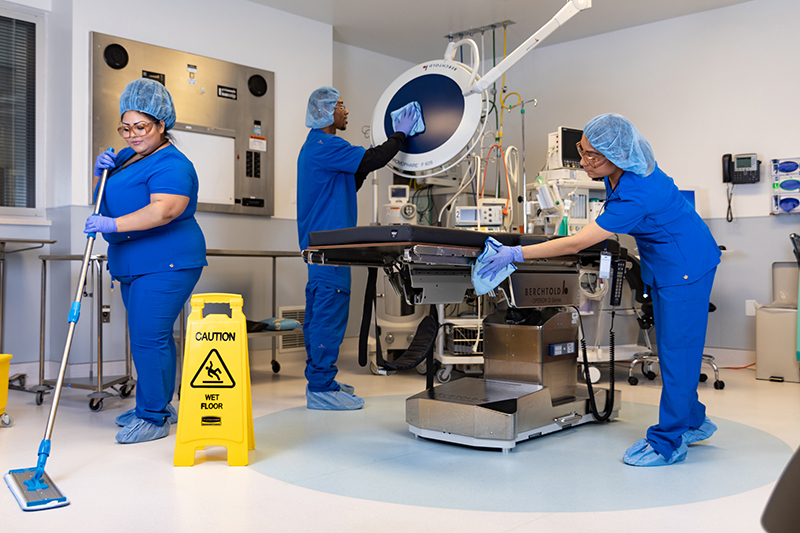 In a healthcare setting, cleanliness is more than just a matter of aesthetics. The cleaning and disinfecting methods have a direct impact on patient health and if done improperly, can result in exposure to significant health risks. The cleanliness of a healthcare setting can also impact the patient experience and satisfaction. Over the past two years, there is no doubt that the importance of cleanliness has changed. McKinsey reports that one in four people now say that cleanliness and sanitation are the top factors determining where they do business. In a healthcare setting, this is even more vital. A clean environment helps patients feel more confident in the care they are receiving. The following EVS practices can help you to ensure a safer, cleaner, and healthier environment for your patients:
In a healthcare setting, cleanliness is more than just a matter of aesthetics. The cleaning and disinfecting methods have a direct impact on patient health and if done improperly, can result in exposure to significant health risks. The cleanliness of a healthcare setting can also impact the patient experience and satisfaction. Over the past two years, there is no doubt that the importance of cleanliness has changed. McKinsey reports that one in four people now say that cleanliness and sanitation are the top factors determining where they do business. In a healthcare setting, this is even more vital. A clean environment helps patients feel more confident in the care they are receiving. The following EVS practices can help you to ensure a safer, cleaner, and healthier environment for your patients:
Conduct a Risk-Based Environmental Cleaning Assessment to Inform Your Processes
According to the Centers for Disease Control, you should develop plans for environmental cleaning procedures for each type of patient care area, based upon three key elements: 1) the probability of contamination, 2) vulnerability of patients and 3) the potential of exposure to pathogens. Conduct a thorough risk assessment and identify these factors for each area in your healthcare facility. An assessment allows you to define the frequency, process, and essential procedures necessary to minimize risks and optimize safety. Understanding risks can be a challenge. Hiring an experienced professional with deep knowledge of environmental services (EVS) and other healthcare-related facility services, such as Marsden Services, can help ensure your facility remains compliant with all American Hospital Association regulations.
Choose the Right Environmental Cleaning Supplies and PPE Products
In healthcare settings, facility services managers and environmental service staff play a significant role in controlling the spread of infection. Prevention starts by protecting EVS staff with the proper personal protective equipment (PPE) and essential janitorial equipment designed for healthcare-specific tasks. In addition to PPE and janitorial equipment, you should also use EPA-registered disinfectants and cleaning products designed and proven for healthcare-specific environments and different types of surfaces. The proper process for cleaning in a healthcare environment is also imperative; make sure your EVS teams are extensively trained in the methods for cleaning the environment.
Proper Training for Disinfection in Healthcare Environments
Your EVS staff aren’t the only team members to train. The CDC also recommends proper training of all healthcare professionals (HCP) involved in providing patient care. Ensuring everyone understands the essential elements of cleaning and disinfecting. EVS and HCP should receive training on cleaning protocols, pathogen transmission, PPE use, chemical and cleaning supplies, and other infection control protocols like safe disposal of sharps. There are multiple evidence-based approaches to ensuring your EVS staff receive the proper training, including the American Hospital Association’s Certified Healthcare Environmental Services Professional (CHESP) program, Certified Healthcare Environmental Services Technician (CHEST) program, and Certified Surgical Cleaning Technician (CSCT) associates.
Implement and Monitor Protocols That Meet American Hospital Association Regulations
To ensure your quality control processes meet or exceed all regulatory requirements and support patient outcomes, implement a proper monitoring system. Monitoring ensures your methods are working and effectively stopping the spread of infection. Protocols for monitoring can include checklists, direct observation, and ATP testing. ATP tests quickly assess surface cleanliness by measuring the level of organic material that remains on a surface following sanitation and disinfection.
Staying abreast of the latest technologies and regulations can be a challenge. One way to minimize risk is hiring an experienced environmental services provider, like Marsden Services, to implement the proper management, quality assurance inspections, and training processes that exceed AHA regulations and inspection standards.
Want to learn more? Read what we’re reading:
- https://www.hfmmagazine.com/articles/4261-overcoming-cleaning-challenges-in-health-care-facilities
- https://www.healthcarefacilitiestoday.com/posts/Perception-of-hospital-cleanliness-can-impact-patient-satisfaction–943
- https://www.cdc.gov/hai/prevent/resource-limited/cleaning-procedures.html
- https://www.cdc.gov/hai/prevent/environment/surfaces.html
